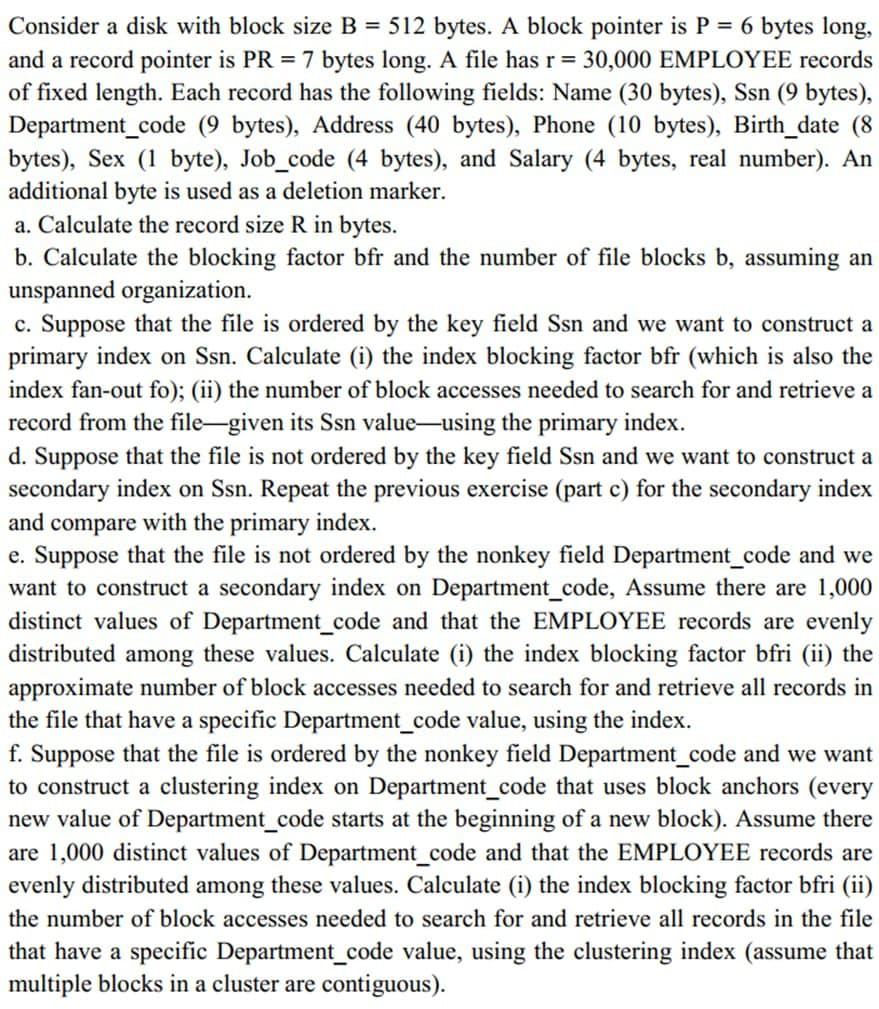d. Suppose that the file is not ordered by the key field Ssn and we want to construct a secondary index on Ssn. Repeat the previous exercise (part c) for the secondary index and compare with the primary index.
d. Suppose that the file is not ordered by the key field Ssn and we want to construct a secondary index on Ssn. Repeat the previous exercise (part c) for the secondary index and compare with the primary index.
Computer Networking: A Top-Down Approach (7th Edition)
7th Edition
ISBN:9780133594140
Author:James Kurose, Keith Ross
Publisher:James Kurose, Keith Ross
Chapter1: Computer Networks And The Internet
Section: Chapter Questions
Problem R1RQ: What is the difference between a host and an end system? List several different types of end...
Related questions
Question
Please solve d,e and f

Transcribed Image Text:Consider a disk with block size B = 512 bytes. A block pointer is P = 6 bytes long,
and a record pointer is PR 7 bytes long. A file has r = 30,000 EMPLOYEE records
of fixed length. Each record has the following fields: Name (30 bytes), Ssn (9 bytes),
Department_code (9 bytes), Address (40 bytes), Phone (10 bytes), Birth_date (8
bytes), Sex (1 byte), Job_code (4 bytes), and Salary (4 bytes, real number). An
additional byte is used as a deletion marker.
a. Calculate the record size R in bytes.
b. Calculate the blocking factor bfr and the number of file blocks b, assuming an
unspanned organization.
c. Suppose that the file is ordered by the key field Ssn and we want to construct a
primary index on Ssn. Calculate (i) the index blocking factor bfr (which is also the
index fan-out fo); (ii) the number of block accesses needed to search for and retrieve a
record from the file-given its Ssn value-using the primary index.
d. Suppose that the file is not ordered by the key field Ssn and we want to construct a
secondary index on Ssn. Repeat the previous exercise (part c) for the secondary index
and compare with the primary index.
e. Suppose that the file is not ordered by the nonkey field Department_code and we
want to construct a secondary index on Department_code, Assume there are 1,000
distinct values of Department_code and that the EMPLOYEE records are evenly
distributed among these values. Calculate (i) the index blocking factor bfri (ii) the
approximate number of block accesses needed to search for and retrieve all records in
the file that have a specific Department_code value, using the index.
f. Suppose that the file is ordered by the nonkey field Department_code and we want
to construct a clustering index on Department_code that uses block anchors (every
new value of Department_code starts at the beginning of a new block). Assume there
are 1,000 distinct values of Department_code and that the EMPLOYEE records are
evenly distributed among these values. Calculate (i) the index blocking factor bfri (ii)
the number of block accesses needed to search for and retrieve all records in the file
that have a specific Department_code value, using the clustering index (assume that
multiple blocks in a cluster are contiguous).
Expert Solution
This question has been solved!
Explore an expertly crafted, step-by-step solution for a thorough understanding of key concepts.
This is a popular solution!
Trending now
This is a popular solution!
Step by step
Solved in 2 steps

Recommended textbooks for you

Computer Networking: A Top-Down Approach (7th Edi…
Computer Engineering
ISBN:
9780133594140
Author:
James Kurose, Keith Ross
Publisher:
PEARSON

Computer Organization and Design MIPS Edition, Fi…
Computer Engineering
ISBN:
9780124077263
Author:
David A. Patterson, John L. Hennessy
Publisher:
Elsevier Science

Network+ Guide to Networks (MindTap Course List)
Computer Engineering
ISBN:
9781337569330
Author:
Jill West, Tamara Dean, Jean Andrews
Publisher:
Cengage Learning

Computer Networking: A Top-Down Approach (7th Edi…
Computer Engineering
ISBN:
9780133594140
Author:
James Kurose, Keith Ross
Publisher:
PEARSON

Computer Organization and Design MIPS Edition, Fi…
Computer Engineering
ISBN:
9780124077263
Author:
David A. Patterson, John L. Hennessy
Publisher:
Elsevier Science

Network+ Guide to Networks (MindTap Course List)
Computer Engineering
ISBN:
9781337569330
Author:
Jill West, Tamara Dean, Jean Andrews
Publisher:
Cengage Learning

Concepts of Database Management
Computer Engineering
ISBN:
9781337093422
Author:
Joy L. Starks, Philip J. Pratt, Mary Z. Last
Publisher:
Cengage Learning

Prelude to Programming
Computer Engineering
ISBN:
9780133750423
Author:
VENIT, Stewart
Publisher:
Pearson Education

Sc Business Data Communications and Networking, T…
Computer Engineering
ISBN:
9781119368830
Author:
FITZGERALD
Publisher:
WILEY